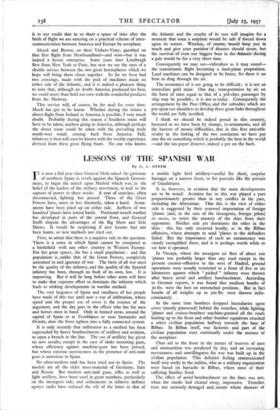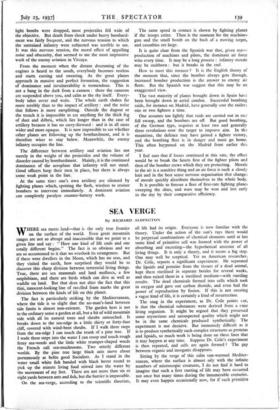LESSONS OF THE SPANISH WAR_ By G. - L. STEER I T
is now a full year since General Mola raised the garrisons of northern Spain in revolt against the. Spanish Govern- ment, to begin the march upon Madrid which was, in tile belief of the leaders of the military movement, to lead to the capture of power in three weeks. A year of ceaseless, often disconnected, fighting has passed. Three of the (rest Powers have, more or less discreetly, taken a hand. Arma- .ments have been piled up on either side. Airfleets of two hundred 'planes have joined battle. Positional trench warfare has developed in parts of the central front, and General Staffs dispute the advantages of the Big Show and Side Shows. It would be surprising if new lessons had not been learnt, or new methods not tried out.
First, to admit that there is a negative side to the question. There is a sense in which Spain cannot be compared as a battlefield with any other country in Western Europe. For her great spaces, she has a small population : and this population is, unlike that of the Great Powers, completely untrained in and ignorant of war. The basis of all war must be the quality of the infantry, and the quality of the Spanish infantry has been, through no fault of its own, low. It is improving. But it will be long before other arms will have to make that supreme effort to dominate the infantry which leads to striking developments in warlike method.
The very largeness of Spain and smallness of her people have made of this war until now a war of infiltration, where speed and the proper use of cover is the essence of the argument, and the day goes to the officer who has his men and horses most in hand. Only in limited areas, around the capital of Spain or at Pozoblanco or near Santander and Oviedo, does the front tighten into a fully connected system.
It is only recently that infiltration as a method has been - superseded by heavy bombardments of artillery and aviation, to open a breach in the line. The use of artillery has given no new results, except in the case of tanks mounting guns, whose efficiency against machine-guns has been proved, but whose extreme nervousness in the presence of anti-tank guns is notorious in Spain.
No ultra-modern tank has been tried out in Spain. The models are all the older mass-material of Germany, Italy and Russia. But modem anti-tank guns, rifles as well as light artillery, have been used in great numbers, particularly on the insurgent side, and refinements in infantry defence against tanks have reduced the role of the latter to that of a mobile light field aitilierY=useful for shori, surprise barrages on a narrow front, or for pnrsiiits like the pursuit of Guadalajara.
It is, however, in aviation that the main developments are to be noted. Aviation has in this war played a part proportionately greater than in any conflict in the past, including the Abyssinian. That this is the view of either side is suggested by their renewed importation of foreign 'planes (and, in the case of the insurgents, foreign pilots) en masse, to wrest the mastery of the skies from their opponents. Neither side yet dominates the other in the skies : this has only occurred locally, as in the Bilbao offensive, where attempts to send !planes to the defenders failed. But the. importance of such an ouranocracy was clearly exemplified there, and it is perhaps worth while to see how it operated.
In Viscaya, where the insurgent air fleet of about too 'planes was probably larger than any used except in- the present counter-offensive to the west of Madrid, ground operations were usually restricted to a front of five or six kilometres against which " picked " infantry were thrown after heavy aerial and artillery bombardment. According to German reports, it was found that medium bombs of 5o lbs. were the best on entrenched positions, But in fact bombs of all weights up to 500 lbs. were thrown , indis- criminately. 1 At the same time bombers dropped incendiaries upon cover (mostly pinewood) behind the trenches, while fighting 'planes and cruiser-bombers machine-gunned .all the , roads leading up to the front and other bomber squadrons attacked a select civilian population halfway towards the base of Bilbao. In Bilbao itself, war factories and part of the civilian population were continually under the menace of the aeroplane.
Thus aid to the front in the matter of reserves of men and ammunition was paralysed by day, and an increasing nervousness and unwillingness for war was built up in the civilian population. This defeatist feeling communicated itself very easily to the militia, who as a military organisation were based on barracks in Bilbao, where most of their suffering' families lived.
The effect of aerial bombardment on the lines was not, when - the smoke had cleared away, impressive. Trenches were not seriously damaged and, except where showers of light bombs were dropped, most projectiles fell wide of the objective. But death from shock under heavy bombard- ment was fairly frequent, and the nervous tension to which the untrained infantry were subjected was terrible to see. It Was this nervous tension, the moral effect of appalling noise and obscurity, that seemed to me the most impressive work of the enemy aviation in Viscaya.
From the moment when the distant drumming of the engines is heard to the south, everybody becomes restless and starts cursing and swearing. As the great planes approach in massive and perfect fonnation, the suggestion of dominance and invulnerability is tremendous. This is not a bang in the dark from a .cannon : there the cannons are suspended above you, and calm as the sky itself. Every- body takes cover and waits. The whole earth shakes far more terribly than to the impact of artillery : and the noise that follows is more earsplitting. Outside the dugout or the trench it is impossible to see anything for the thick fog of dust and debris, which lies longer than in the case of artillery because it has no carry-forward : and is in all cases wider and more opaque. It is now impossible to see whether other planes are following up the bombardment, and it is therefore wiser to stay below. Meanwhile, the enemy infantry occupies the line.
The difference between artillery and aviation lies not merely in the weight of the projectiles and the volume of disorder caused by bombardment. Mainly, it is the continued dominance of the aeroplane that infantry will not stand. Good officers keep their men in place, but there is always some weak point in the line.
At the same time one's own artillery are silenced by fighting planes which, spotting the flash, wireless to cruiser bombers to intervene immediately. A dominant aviation can completely paralyse counter-battery work. The same speed in contact is shown by fighting planes if the troops retire. Then is the moment for the machine-. gun and the small bomb on the back of a moving target, and casualties are large.
It is quite clear from the Spanish war that, given macs- production of machines and pilots, the dominant air force wins every time. It may be a long process : infantry morale may be stubborn : but it breaks in the end.
How to meet this menace ? It is the English theory of the moment that, since the bomber always gets through, increased bomber production is the answer to enemy air fleets. But the Spanish war suggest that this may be an exaggerated view.
The vast majority of planes brought down in Spain have been brought down in aerial combat. Successful bombing raids, for instance on Madrid, have generally cost the raiders one or two fighters a time.
One assumes too lightly that raids are carried out in on fell swoop, and the bombers are off. But good bombing, of the German type, requires at least two and generally three revolutions over the target to improve aim. In th.: meantime, the defence may have gained a fighter victory, and the bombing fleet is in danger and must go home. This often happened on the Madrid front earlier this year.
I feel sure that if losses continued at this rate, the effect would be to break the hearts first of the fighter pilots and then of the bomber crews which they are protecting. Morale in the air is a sensitive thing and an air force is such a closely knit and in the best sense nervous organisation that change; of morale quickly distribute themselves to the whole body.
It is possible to foresee a fleet of first-rate fighting planes sweeping the skies, and wars may be won and lost early in the day by their comparative efficiency.































































 Previous page
Previous page